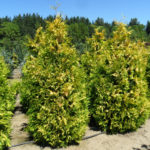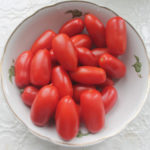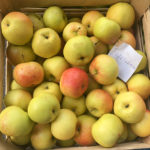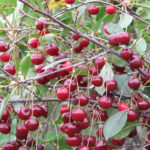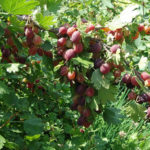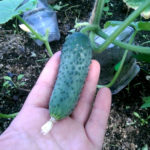Planting and growing dill on the windowsill
Recently, urban dwellers have a trend of growing spicy greens on windowsills. Watercress, basil, parsley, dill are just some of the crops that find shelter there. In this article, we will focus on growing the latter.

Is it worth it to grow this plant on the windowsill - everyone is free to choose for himself, but if such a decision has already been made, then you need to be patient, because the harvest will have to wait 1.5-2 months. It is also necessary to remember that dill is a light-loving culture, therefore, when grown in the autumn-winter period, additional lighting will have to be organized, which requires some financial costs.
Both early maturing and late maturing varieties can be grown on the windowsill. When cultivating early ripe ones (for example, Gribovsky), you can quickly get fresh greens, but the plants also throw out flower stalks early, so you should not count on a rich harvest. Late ripening ones (for example, Alligator) are much more productive - they form dense bushes and give new shoots from axillary buds.
Pre-sowing preparation
The fruits of dill accumulate a large amount of essential oils containing germination inhibitors - for this reason, it takes a long time before germination appears. To accelerate germination, the seeds are soaked in warm water for 1-2 days, changing it every 12 hours. It is advisable to soak in a thermos. By the way, if after a day some of the seeds float on the surface of the liquid, it is better to throw them away. The highest quality specimens sink to the bottom - they give amicable and strong shoots.
In order to prevent fungal diseases, the seeds are treated with a weak solution of potassium permanganate for 4-5 hours, after which they are washed and dried. In specialized stores, you can buy the latest preparations intended for pre-sowing treatment of seed material in order to prevent fungal and viral infections - they can be successfully used for pre-sowing treatment of dill fruits.
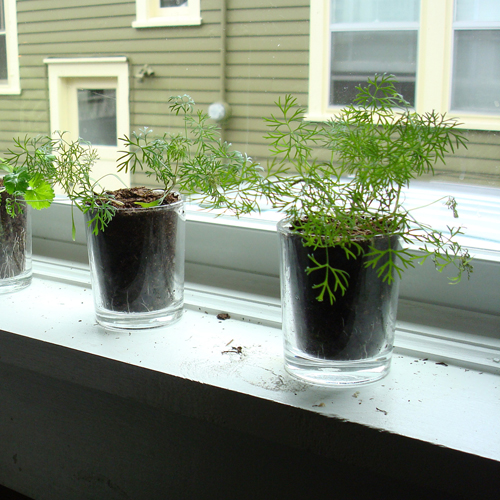
Selection and preparation of soil
Plants can be grown both using fertile soil and using inert materials - in the latter case, it becomes necessary to carry out regular fertilizing.
To grow this crop, you can use ordinary garden soil mixed with purchased soil for indoor flowers and agroperlite (vermiculite). The approximate ratio of these materials is 3: 2: 1. Another good option is a mixture of vermicompost with coconut fiber in a 1: 2 ratio. Perlite (vermiculite) or coconut fiber perfectly absorb excess moisture, and, if necessary, easily give it away, which allows you to reduce the amount of regular watering.
Planting (sowing)
Any container with a height of at least 15 cm is suitable for growing dill, but plastic boxes are better suited for this purpose, which can be compactly placed on the windowsill. Drainage holes should be provided at the bottom of the sowing containers for the outflow of excess irrigation water. A layer (2-3 cm) of expanded clay or gravel is laid at the bottom of the planting tank, and then the pre-calcined soil is poured.
Seeds are evenly distributed over the surface of the moistened soil, sprinkled with a layer of earth of 1-2 cm and watered. At the end of the sowing activities, the containers are covered with plastic wrap and placed in a warm place. At a temperature of 18-20 ° C, seedlings appear in 1-2 weeks.
After the emergence of seedlings, the film is removed, and the planting containers are placed on the windowsill.
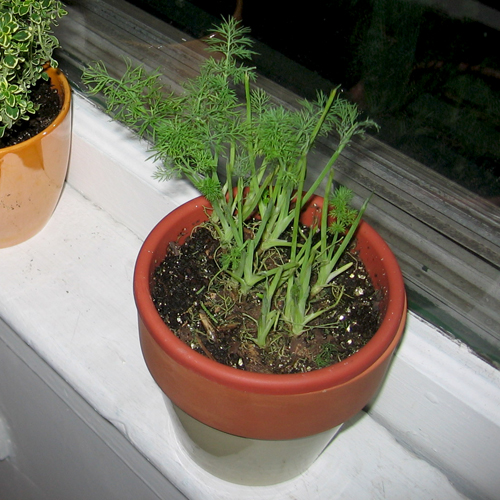
Early maturing varieties are grown on a "conveyor" type, with repeated sowing every 10 days.
Planting care
On the 21-25 day after the emergence of seedlings, the crops are thinned so that the feeding area for one plant is 3 cm square for early-ripening varieties, and 5-8 cm square for late-ripening varieties.
For normal development, plants need a lot of light, and daylight hours should be within 14-15 hours. Even in the spring-summer period, it is recommended to supplement planting illumination for 4-5 hours, and in winter additional illumination is turned on for at least 12 hours. For supplementary lighting, you can use fluorescent lamps, which are used by aquarists, but phyto-LEDs of the full spectrum are most suitable for this purpose.
The optimal temperature range for growing dill is 18-20 ° C, although the plants also tolerate temperatures as low as 10 ° C.
In the summer, the crop requires abundant daily watering so that the soil surface is constantly slightly moist. In winter, crops are moistened moderately when the soil surface dries out after the last watering. Plants cannot stand water stagnation - this is fraught with the development of a black leg, which will certainly lead to their death.
Crops are responsive to spraying - this is especially true in winter, during the heating season, when the air in the apartment is too dry. When spraying, a complex mineral fertilizer with microelements can be added to the water (no more than 1 time per week).
When using fertile soil, top dressing is not required.
Harvesting begins 40-50 days after germination, breaking off the apical leaves - this stimulates the development of lateral shoots.
Diseases and pests
The most common diseases in dill include powdery mildew, blackleg and fusarium. All of these diseases are provoked by various types of fungi that live in the soil, which is why the soil must be calcined before use.
